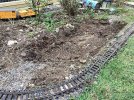Hi. I had a hernia op a couple of weeks ago so not able to carry Out the groundwork’s on my very modest layout. Before the op I’d started digging out the centre of the bottom loop of my layout with a view to building a wooden platform to lay out my village and station. We are in a relative new build house (4 years old). They have been constructing further housing on fields at the back of the property and I feel this has altered the water table on our estate. Sorry for the waffle but I need some advice. During the last couple of weeks the extensive rain we’ve had has converted my digging out into a pond. The water level seems to have maximised at around 2 to 3 inches below my track.
I’m thinking now of raising that end of the track to make certain the water isn’t going to disrupt the line. There is a slight gradient to the top loop so this in theory would be a way of levelling it. I’ve not considered a raised track even though most people seem to as my wife wanted the track to have a low impact on the garden but it seems to be a sensible move. Does anyone have any alternative suggestions or if not what’s the best way to build the track Ed up?
sorry for the essay rather than a request for help but I hope this makes sense. I’m attaching some photos to give an idea of what’s going on.



I’m thinking now of raising that end of the track to make certain the water isn’t going to disrupt the line. There is a slight gradient to the top loop so this in theory would be a way of levelling it. I’ve not considered a raised track even though most people seem to as my wife wanted the track to have a low impact on the garden but it seems to be a sensible move. Does anyone have any alternative suggestions or if not what’s the best way to build the track Ed up?
sorry for the essay rather than a request for help but I hope this makes sense. I’m attaching some photos to give an idea of what’s going on.







